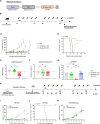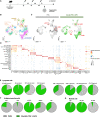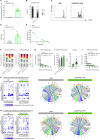A bispecific Clec9A-PD-L1 targeted type I interferon profoundly reshapes the tumor microenvironment towards an antitumor state
- PMID: 38031106
- PMCID: PMC10685570
- DOI: 10.1186/s12943-023-01908-6
A bispecific Clec9A-PD-L1 targeted type I interferon profoundly reshapes the tumor microenvironment towards an antitumor state
Abstract
Despite major improvements in immunotherapeutic strategies, the immunosuppressive tumor microenvironment remains a major obstacle for the induction of efficient antitumor responses. In this study, we show that local delivery of a bispecific Clec9A-PD-L1 targeted type I interferon (AcTaferon, AFN) overcomes this hurdle by reshaping the tumor immune landscape.Treatment with the bispecific AFN resulted in the presence of pro-immunogenic tumor-associated macrophages and neutrophils, increased motility and maturation profile of cDC1 and presence of inflammatory cDC2. Moreover, we report empowered diversity in the CD8+ T cell repertoire and induction of a shift from naive, dysfunctional CD8+ T cells towards effector, plastic cytotoxic T lymphocytes together with increased presence of NK and NKT cells as well as decreased regulatory T cell levels. These dynamic changes were associated with potent antitumor activity. Tumor clearance and immunological memory, therapeutic immunity on large established tumors and blunted tumor growth at distant sites were obtained upon co-administration of a non-curative dose of chemotherapy.Overall, this study illuminates further application of type I interferon as a safe and efficient way to reshape the suppressive tumor microenvironment and induce potent antitumor immunity; features which are of major importance in overcoming the development of metastases and tumor cell resistance to immune attack. The strategy described here has potential for application across to a broad range of cancer types.
Keywords: AcTakine; Cancer immunotherapy; Immune checkpoint; Tumor microenvironment; Type I Interferon.
© 2023. The Author(s).
Conflict of interest statement
NK and JT are affiliated with Orionis Biosciences NV and hold equity interests. NK and JT have no additional financial interests. The following patent applications are related to the work presented in this paper: WO/2017/134305, Bispecific signaling agents and uses thereof. Applicants: VIB-Ghent University and Orionis Biosciences N.V. Inventors: N.K., J.T., S.V.L., A.C. The remaining authors declare no competing interests.
Figures










References
Publication types
MeSH terms
Substances
Grants and funding
LinkOut - more resources
Full Text Sources
Medical
Research Materials
Miscellaneous

